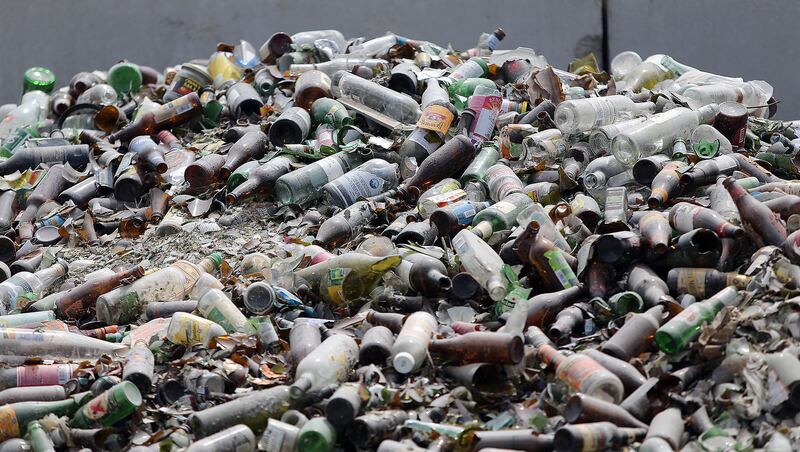Utah has a fairly robust glass recycling “ecosystem,” says Stevie Norcross.
That’s because Momentum Recycling operates as a glass recycling facility in Salt Lake County, while Owens Corning’s plant in Nephi takes recycled glass and manufactures it into new products, primarily fiberglass building insulation, said Norcross, assistant director of the Utah Division of Waste Management and Radiation Control. Some glass in southern Utah can also be sent to a facility in Las Vegas.
“Utah is at an advantage for glass recycling, and I think it’s good to continue to help boost that system we have in place,” she told members of the Utah Legislature’s Natural Resources, Agriculture, and Environment Interim Committee on Tuesday.
However, she warns that glass recycling is much easier in some parts of the state than others.
Norcross presented findings of a study on glass recycling to the committee to comply with HB177, which lawmakers passed earlier this year. It was inspired by uncertainty about how to handle $4 million worth of glass from the North Capitol building as it was being demolished for the new state museum, members of the interim committee explained.
The bill required the Utah Division of Waste Management and Radiation Control to study ways to increase the amount of glass that is recycled in the state, and report its findings to the interim committee by the end of September.
Recycling is most accessible along or near the Wasatch Front and in the areas close to Momentum Recycling, the agency found. Davis, Salt Lake, Summit, Utah and Weber are the only counties in the state that currently offer both curbside and drop-off glass recycling opportunities.
Curbside pickups are possible in Duchesne, Iron, Juab, Kane, Sanpete, Uintah and Wasatch counties, while there are dropoff options in Cache, Grand and Washington counties. Neither option is currently available for the remaining 14 counties scattered across the state.
“As you go to rural counties, those services drop off,” Norcross said. “One of the barriers and reasons for that is it’s expensive to transport the glass material, and it gets more expensive the further you are from the recycling facility.”
The division also outlined four potential solutions to enhance glass recycling in the state.
4 potential glass recycling policy changes, as recommended by the Utah Division of Waste Management and Radiation Control
-
Require glass recycling to be considered as part of the “all state solicitations” associated with state-owned buildings being remodeled or demolished. Planning could reduce the types of headaches experienced with the North Capitol Building project.
-
Support polices that prioritize the use of recycled glass products to increase recycling in the state. Recycled glass is often used to manufacture products like fiberglass insulation, blasting, filter and drainage material, asphalt, concrete, tiles and landscaping materials.
-
Increase dropoff locations in communities. The state could require a glass recycling dropoff bin at every state liquor store location, or within a certain radius of one.
-
Require municipalities with a current or future inland port to consider using their port site to transport glass waste or other recyclable materials to a Utah recycling facility. The main port is in Salt Lake City, but the port authority has since outlined 13 other project areas all over the state. Trains sending materials from urban to rural communities are often full, but return empty, and this would at least transport something back, officials said.
Officials are still working to study materials that end up in landfills by reviewing materials collected at 30 different sites in the state, which will help determine which parts of the state are more likely to throw out glass. That data is expected to be completed by early 2026, following a delay in Environmental Protection Agency funding, Norcross said.
Of the proposed solutions, encouraging glass recycling products has only become more timely since the study began. Owens Corning announced that it planned to lay off 67 employees of its Nephi plant by the end of October, in compliance with the state’s WARN Act.
Committee members said Tuesday the current “lack of demand” for products like fiberglass insulation led to the business’s decision.
“We need to get our building back up and going (for) our economy,” said Sen. Derrin Owens, R-Fountain Green, who also served as a floor sponsor of HB177. “I appreciate the study and these recommendations. … This is helpful, and I think it’ll move us forward.”
What was presented is more of a “starting point,” said Doug Hansen, director of the Utah Division of Waste Management and Radiation Control. He adds that he’s aware it would require coordination with other state agencies.
Yet, some of the recommendations could be implemented in new bills. Owens said he planned to meet with Rep. Douglas Welton, R-Payson, the lawmaker behind HB177, to consider opening bill files for legislation tied to the report recommendations.
More details about the cost to collect more glass, especially from rural communities, could also be hammered out by then, addressing concerns brought up in the meeting. The next legislative session begins on Jan. 20, 2026.









